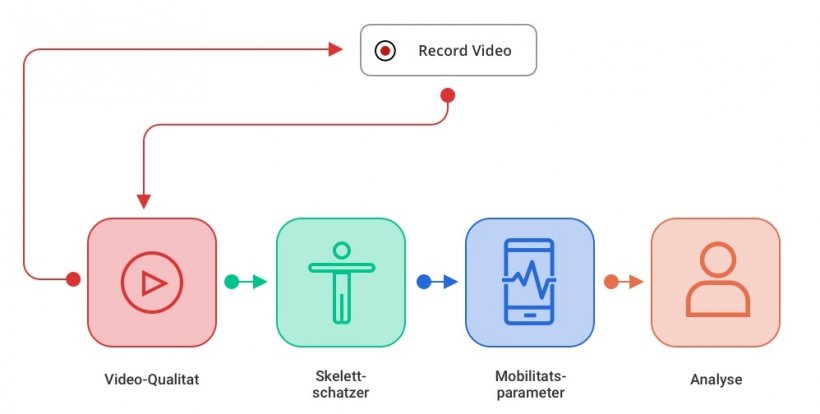
Source: Lindera GmbH
News • Intelligent algorithms
The gait lab for the pocket – app-based fall prevention
Every day, elderly people fall – be it at home or in care facilities. The med-tech start-up Lindera aims to reduce the risk of falling with the help of artificial intelligence (AI): the company developed an app that allows motion analysis via a smartphone camera and offers the user recommendations on how to minimize the risk of falling.
Report: Mareike Scholze / Sascha Keutel
The risk for falls increases with age. Falls and their consequences are a burden on the person falling and their families – but also on the healthcare system. The need for professional care increases, but is difficult to meet due to a shortage of trained staff. “The problem for the patients: there are no anti-fall pills,” says Diana Heinrichs, founder and managing director of Lindera GmbH.
From family to company
The idea for the app was born from experiences in her family. Heinrichs, a former manager at Microsoft, realized “that we urgently need new approaches and innovation to solve the care issues” when her mother started to care for her grandmother full-time.
She took a sabbatical and started working for an out-patient care service. The private and professional experiences strengthened her resolve to use intelligent technologies in order to lastingly improve the situation of people who are ill or have limited mobility or require care. Her first question: “What would be a systematic approach to reducing the risk for falls?”
Motion assessment test with SturzApp
After in-depth conversations with physicians the idea to develop an app that performs a geriatric assessment based on videos and a questionnaire came up. Thus SturzApp was born. It can be used by physicians, care staff and family members and requires only a commercially available smartphone. No additional sensors and other hardware are needed.
The user records a 30-second video of the patient walking which is then automatically analysed. 3D motion tracking technologies and a machine-learning algorithm assess movement based on medically validated parameters. The algorithm for the 3D skeleton avatar recognizes each necessary parameter within millimetre range. “The measurement accuracy is at the level of the previous gold standard,” Heinrichs explains.
Since physical factors are only part of the overall risk, carers also fill in a psycho-social questionnaire which is based on the current standard on fall prophylaxis.
Using evidence-based data the app assesses the risk for falls and recommends personalized preventive measures such as exercises to strengthen certain muscle groups. “Our app contains the scores that are relevant for the users to make decisions. By digitalizing the risk factors and the planning of measurements, we reduce the documentation effort, accelerate the processes and make them more precise,” Heinrichs points out.

Source: Lindera GmbH
Clinical movement analysis
In addition to the SturzApp for carers, Lindera is developing a second app that can be integrated in clinical work flows. This tool does not aim to recognize risks for falls but is designed to accompany the patient‘s recovery and support the therapist’s decision-making. “KlinikApp is a kind of Swiss army knife for movement analysis,” Heinrich says. Its modular design is geared towards areas with standardised tests. From a wide range of functional assessments physicians and therapists can select the test they need to diagnose and treat their patients.
“We validated each tool for each indication, such as the chair stand test, Tinetti test or the Neutral-Zero-Method,” Heinrich says and adds that the app offers questionnaires to collect other kind of data such as the visual analogue scale (VAS) or the Staffelstein score.

Source: Lindera GmbH
The app can be easily integrated into an existing HIS: “We did not reinvent the medical wheel but we digitalised widely used scores and linked them to the documentation which we then digitalised as well. Thus we were able to optimise the processes in the hospital,” Heinrich points out and adds: “During hospital admission, treatment and discharge many of these parameters can be analysed. For example, we can compare the physical state of the patient before and after surgery and during the post-operative rehabilitation.”
The app supports the data exchange both within the hospital and with other facilities: “Our system is a coordinating link between all sectors of the healthcare system: GP, specialist physician, hospital, rehab. And it is always based on scientifically validated data,” Heinrichs underlines.
Upon request the company provides the raw data which the physicians can integrate in their own analysis system: “We can do that because we have standardised the processes and we had the precision of our data scientifically validated by a third party.”

Profile:
Diana Heinrichs founded Lindera GmbH in 2017. Before, she was PR professional and Business Development Manager with Microsoft Germany.
The start-up focuses on AI-based 3D movement analyses for digital health, care and fitness applications. Combining medical knowledge and intelligent AI technologies the interdisciplinary Lindera team was able to generate precise gait parameters with a simple monocular camera which today is part of any smartphone or tablet and to scientifically validate them on the highest quality level.
The article was first published on tectales.com.
31.12.2021










